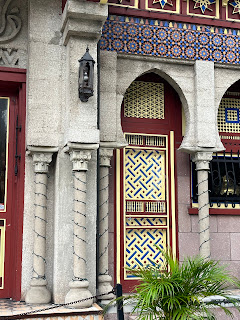Historic Architecture
Research
Building #1: Villa Zoryada
- There are lots of primary colors, red, yellow, and blue incorporated into the architecture.
- Patterns are utilized, mainly through colorful tiles.
- Lots of designs are carved into the concrete, geometric shapes, lines, and arches.
Villa Zoryada was built by Franklin W. Smith in 1833 as his winter home, it was the first building in Florida to be made out of concrete and it caught the attention of Henry Flagler who used the method of pouring cement and adding crushed coquina rocks for his other buildings, the Ponce de Leon Hotel and the Alcazar Hotel. After about 20 years the home was turned into a social club for the elite. In 1913 the property was sold to Abraham Mussallem, in the 1920s it became a gambling casino/speakeasy, and in the later 1920's the Mussallem family lived in the residence. After several years in 1933, the family realized the important history behind the building and opened it as the Villa Zoryada Museum we know today.
Our History. (2024, April 4). Villa Zorayda Museum. https://villazorayda.com/our-history/
Building #2: Lightner Museum
- Lots of repetition is used throughout this building, repeating window shapes, archways etc.
- Line is utilized, divided sections of the building, height and length of the building, it extended into the horizon line.
- The foundation of the building is fairly plain, but the roof has very detailed carvings in a terracotta color that stands out in comparison to the gray of the concrete.
- Intricate metal balconies feels very lavish.
- The building is white in comparison to the others around it which are gray (concrete) feels more expensive.
- Embellishments at the tops of the buildings, has a castle feel.
- Lots of line is utilized, which helps make repeating patterns.
Sketches
Sketch #1
Sketch #3

























No comments:
Post a Comment